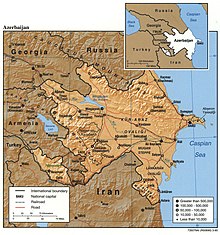Azerbaijan–Russia border

Azerbaijan–Russia border (
Description
The border starts in the west at the Georgian tripoint and proceeds in south-eastwards direction over various mountain ridges of the Caucasus Mountains, before turning to the north-east roughly halfway and then proceeding along the Samur river valley to the Samur Delta on the Caspian Sea coast. Mount Bazardüzü, the highest peak in both Dagestan and Azerbaijan, lies on the frontier. Parts of the border are fenced and equipped with technical facilities including barbed wire, sensors and cameras.
History
During the 19th century the Caucasus region was contested between the declining
During the
The boundary became an international frontier in 1991 following the dissolution of the Soviet Union and the independence of its constituent republics. Border demarcation discussions then began, being completed in September 2010.[5] Following ratification it entered into force the following year. The border agreement was criticised by some Communist Party deputies of the Russian State Duma, however the then head of Dagestan Magomedsalam Magomedov said that "Dagestan has not lost anything, but gained a lot more".[6][7]
Border crossings

There are four border crossings:
- Samur (AZE) - Yarag-Kazmalyar (RUS)[8]
- Şirvanovka (AZE) - Novo-Filya (RUS) [8]
- Yalama (AZE)- Tagirkent-Kazmalyar (RUS)[8]
- Zuxul (AZE) – Garakh (RUS) (not open to third country nationals)[8]
There is also a train service connecting Derbent (Russia) and Baku (Azerbaijan).[8]
References
- ^ CIA World Factbook - Russia, archived from the original on 9 January 2021, retrieved 8 September 2020
- ^ a b International Boundary Study No. 25 – Iran-USSR Boundary (PDF), 28 February 1978, archived (PDF) from the original on 23 October 2020, retrieved 9 April 2020
- ^ John F. Baddeley, "The Russian Conquest of the Caucasus", Longman, Green and Co., London: 1908, p. 90
- ^ USSR-Iran Boundary (PDF), February 1951, archived from the original (PDF) on 10 April 2020, retrieved 9 April 2020
- ^ Markedonov, Sergey (16 October 2013). "Russia–Azerbaijan: an ambivalent partnership". RIAC. Archived from the original on 28 October 2020. Retrieved 25 September 2020.
- ^ "Мы готовы отказаться от дотаций, но дайте нам льготное налогообложение". Газета.Ru (in Russian). Archived from the original on 2020-10-28. Retrieved 2020-08-27.
- ^ "От России отрезан еще кусок территории Обсуждается в Госдуме". Archived from the original on 2013-10-02. Retrieved 2013-09-28.
- ^ a b c d e "Azerbaijan Border Crossings". Caravanistan. Archived from the original on 28 September 2020. Retrieved 8 September 2020.


